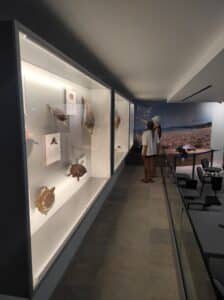Anecdotal evidence that numbers of loggerhead turtles increasing
A team of biologists from the Mediterranean Turtle Research and Conservation Society with local youth volunteers are braving the heatwave to document this year’s turtle hatchling data.
The team of researchers are currently combing the beaches from Akamas to Argaka, section by section, to locate nests and install protective cages and markers.
In the afternoons the team can be seen out and about with hats and clipboards and a lucky visitor might just happen to catch the magical moment when baby turtles (which have remained trapped in their nest) are released on their way to the sea.
Cyprus Mail caught up with one of the team’s experts, biologist Angela Mastrogiacomo, at an Argaka beach, sitting on her haunches sorting unhatched loggerhead eggs in the hot sun, her hands encased in white rubber gloves.
“This nest contained 60 shells and 20 live babies,” she told Cyprus Mail. “But nests can contain over one hundred. A lot of the hatchlings get disoriented by the lights of restaurants or beach bars, even streetlights. Out of a cluster of 60, only 10 to 15 may survive.”
That’s just the ones that make it to the sea, she explains. Thereafter, at best, one in a thousand survive to adulthood.
“Their bodies are dark against the sand so if they get disoriented on their way to the water, they are eaten up by predators in minutes,” Mastrogiacomo explains.
Loggerhead turtles (Caretta caretta) lay eggs about three times a year during their laying season in the summer. Once a female turtle hatchling makes it to the sea, she will not return for 20 years, but she will return to the exact same spot where she was born.
Male turtles will never touch land again, Mastrogiacomo clarified.
The sex of hatchlings is determined by the temperature of the sand – cooler temperatures produce males and warmer temperatures produce females.
“We are very busy this year, it’s been non-stop,” said biologist and environmentalist Simos Demetropoulos, who heads the team. “Training new volunteers each year…it’s a lot of work and it takes time.”
Simos has been working to protect the turtles his whole life, having taken over the baton from his father, Andreas, a well-known champion of island’s turtles, who passed away at the age of 84 last year.
“There are more loggerheads this year but we don’t have all the data in yet,” Demetropoulos said, suggesting that they may possibly be preferring the island’s northwest beaches as the southern ones become more and more inhospitable for them.
Meanwhile, over at the newly opened Turtle Museum and Educational Centre in Ineia, environmental scientist Charalambos Palates told the newspaper that it did appear that overall loggerhead numbers were increasing, however, no systematic research has yet been done with tagging and tracing of animals.
The museum, albeit as yet modest, has appealing visuals and clearly organised information. Particularly fascinating is a hefty (preserved) specimen of a green turtle (Chelonia mydas) moved to the space from the ministry of agriculture.
Exhibits and educational stations provide a comprehensive overview not only of the island’s turtles but of the evolution of turtles from prehistory onwards, informing the visitor of the humbling fact that turtles have swum in the Mediterranean Sea for the past 12,000 years.
“The museum’s first season has been very successful so far, welcoming large numbers of visitors, and we have plans for expansion of the facility,” said Ineia community leader, Yiangos Tsivikos.
The new educational centre also plays an important role as a hub for locals to develop an appreciation for these animals and be motivated to find ways to co-exist, Tsivikos explained.
“It’s important to see ecological tourism plans through to fruition, and create genuinely viable opportunities for long term employment in the villages of Akamas,” the community leader said.
Communities like Ineia, the mukhtar pointedly added, “are the heartlands of Laona, the heart of Akamas.”
Latest available estimates put the island’s population of loggerheads, classified as a ‘vulnerable’ species, at 12,000 to 15,000, while the island’s green turtle visitors, classified as an ‘endangered’ species, are estimated at only 250 to 350 animals.









Click here to change your cookie preferences